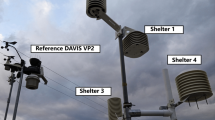Abstract
After the release of radioactive material in the form of radioactive plume from a nuclear power plant (NPP) due to an accident, radioactive plume disperses in the air depending on meteorological factors. During such a dispersion, radionuclides from the plume fall onto the ground. The paramount goal of radiological emergency preparedness is to avoid or—if avoidance is infeasible—minimize exposure of residents to radiation by taking adequate measures for their protection. Tracking the behavior of the radioactive plume and obtaining information on radionuclides deposited on the soil in real time to protect residents around the NPP is necessary. Accordingly, a portable multifunction radiation detector was developed in this study. The significant features of the radiation detector are that it can distinguish and measure gamma radiations incident from below and above the radiation detector separately. In addition, it can distinguish between fast neutrons and gamma radiation in a mixed radiation field. Performance tests revealed that our radiation detector works well as designed.









Similar content being viewed by others
References
S. I. Hwang et al., Towards efficient management of radioactive-contaminated soil and groundwater by nuclear accidents, Korea Environment Institute (2011)
Korea Atomic Energy Research Institute, Basic Document for the Fundamental Emergency Planning Zone of the HANARO Facilities, KAERI/TR2831/2004 (2004)
K. C. Kim, Development of a smart evacuation shelter and its management system in response to NPP accidents, Ph.D. Thesis, University of Chosun (2019)
W. Sohn, G.B. Lee, Y.H. Yang, I.H. Kim, Lesson learned from emergency response of Fukushima accident - Focus on resident evacuation. Proc. Korean Radioactive Waste Soc. 12, 1 (2014)
IAEA, Accident Management Programmes for Nuclear Power Plants, Specific Safety Guide No. SSG-54 (2019)
Korea Institute of Nuclear Safety, The Annual Report on the Environmental Radiological Surveillance and Assessment around the Nuclear Facilities, KINS/AR-140, Vol. 31 (2020)
Y.Y. Ji et al., Determinations of the exposure rate using a NaI(Tl) detector of the environmental radiation monitor. J. Nucl. Fuel Cycle Waste Technol. 11, 3 (2013). https://doi.org/10.7733/jnfcwt-k.2013.11.3.245
Y.Y. Ji et al., A new approach for the determination of dose rate and radioactivity for detected gamma nuclides using an environmental radiation monitor based on an NaI(Tl) detector. Health Phys. 113, 4 (2017). https://doi.org/10.1097/HP.0000000000000706
J.W. Kim, H.Y. Joo, J.H. Moon, G.J. Lee, Development of a radiation detector for the radioactive-plume monitoring network (RPMN). Prog. Nucl. Energy 123, 103290 (2020). https://doi.org/10.1016/j.pnucene.2020.103290
H. M. Zhong, H. Yuan, G. Q. Zeng, Remote measurement and control system of nuclear radiation environmental accident emergency, International Conference on Electronics, Information Technology and Intellectualization, Shenzhen, China, pp. 91–94 (2015)
Y. Sato et al., Remote radiation imaging system using a compact gamma-ray imager mounted on a multicopter drone. J. Nucl. Sci. Technol. 55, 1 (2017)
S.I. Okuyama, T. Torii, A. Suzuki, M. Shibuya, N. Miyazaki, A remote radiation monitoring system using an autonomous unmanned helicopter for nuclear emergencies. J. Nucl. Sci. Technol. 45, 5 (2008)
A. Owens, Compound semiconductor radiation detectors (CRC Press, Boca Raton, 2012)
Acknowledgements
This work was supported by the National Research Foundation of Korea (NRF) grant funded by the Korea government (Ministry of Science and ICT) (No. 2020M2D2A2062436) and by KOREA HYDRO & NUCLEAR POWER CO., LTD. (K-CLOUD 19-technology-04).
Author information
Authors and Affiliations
Corresponding author
Additional information
Publisher's Note
Springer Nature remains neutral with regard to jurisdictional claims in published maps and institutional affiliations.
Rights and permissions
Springer Nature or its licensor holds exclusive rights to this article under a publishing agreement with the author(s) or other rightsholder(s); author self-archiving of the accepted manuscript version of this article is solely governed by the terms of such publishing agreement and applicable law.
About this article
Cite this article
Kim, J.W., Joo, H.Y., Choi, J.S. et al. Development and characterization of a portable multifunction radiation detector for radiological emergency preparedness. J. Korean Phys. Soc. 82, 98–106 (2023). https://doi.org/10.1007/s40042-022-00639-z
Received:
Revised:
Accepted:
Published:
Issue Date:
DOI: https://doi.org/10.1007/s40042-022-00639-z




